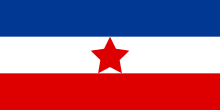16th Division (Yugoslav Partisans)
| 16th Vojvodina Division | |
|---|---|
 Flag of Democratic Federal Yugoslavia (used by the Partisans) | |
| Country | Democratic Federal Yugoslavia |
| Branch | Yugoslav Partisan Army |
| Type | infantry |
| Size | division |
| Part of | Partisan 3rd Corps Partisan 12th Corps Partisan 3rd Army |
| Engagements | World War II in Yugoslavia * Operation Osterei * Operation Maiglöckchen * Operation Vollmond * Operation Heiderose * Belgrade Offensive * Battle of Batina * Syrmian Front * Operation Wehrwolf (Yugoslavia) |
| Commanders | |
| Notable commanders | Danilo Lekić |
The 16th Vojvodina Division (Serbo-Croatian Latin: Šesnaesta vojvođanska divizija) was a Yugoslav Partisan division that fought against the Germans, Independent State of Croatia (NDH) and Chetniks in occupied Democratic Federal Yugoslavia during World War II.
When it was created, the 16th Vojvodina Division consisted of mostly Serbs recruited from Hungarian–occupied Bačka. It constituted the first, second, and third Vojvodinian Brigades and had about 3,000 units when it was formed.[1] By 1941, the Partisan rank-and-file was still predominantly Serbian.[1] The Partisans initial successes included the liberation of the area that surrounded the Serbian town of Užice.[2]
As part of the Partisan 3rd Corps then Partisan 12th Corps, it spent most of 1944 engaged in hard fighting against the 13th Waffen Mountain Division of the SS Handschar (1st Croatian) in eastern Bosnia. The division participated in the Seventh Offensive from March to June 1944.[3]
The division's later conflict with the Chetniks, which grew into a civil war, was rooted on the dispute between the pro-Communist and the nationalist wings of the Serb rebellion.[1]
The Division also participated in the Battle of Batina (November 1944).
Notes
[edit]- ^ a b c Hoare, Marko Attila (2014). The Bosnian Muslims in the Second World War. Oxford: Oxford University Press. ISBN 978-0-19-936531-9.
- ^ Batinić, Jelena (2015). Women and Yugoslav Partisans: A History of World War II Resistance. New York: Cambridge University Press. p. 22. ISBN 978-1-107-09107-8.
- ^ East European Accessions Index. Washington, D.C.: U.S. Government Printing Office. 1953. p. 103.
References
[edit]- Atanacković, Žarko (1978). Druga vojvoðanska NOU brigada [Second Vojvodina NOU Brigade]. Beograd: Vojnoizdavački zavod. OCLC 80355858.
- Grujić, Periša (1959). S̆esnaesta Vojvod̆anska divizija: borbena dejstva od formiranja do oslobođenja zemlje [Sixteenth Vojvodina Division: Combat Activities from Forming to the Liberation of the Country]. Beograd: Vojno delo. OCLC 13108684.
- Lagator, Špiro (1983). Četvrta vojvođanska brigada [Fourth Vojvodina Brigade]. Beograd: Vojnoizdavački zavod. OCLC 255495489.
- Lepre, George (1997). Himmler's Bosnian Division: The Waffen-SS Handschar Division 1943–1945. Atglen, Philadelphia: Schiffer Publishing. ISBN 0-7643-0134-9.
- Vasić, Đorđe; Savić, Sreta (1979). Prva vojvođanska brigada [First Vojvodina Brigade]. Novi Sad: Institut za istoriju. OCLC 441399168.
- Vuksic, Velimir (2003). Tito's Partisans 1941-45. Oxford: Osprey Publishing. ISBN 978-1-841766-75-1.
